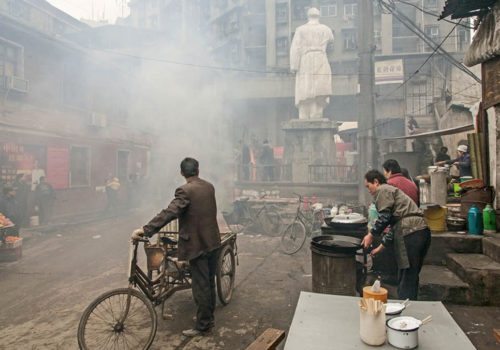The Sun Also Rises
On September 15, 1967, the first statue of Mao Zedong was installed at Tsinghua University in Beijing. The year prior to that, the ‘red guards’ at the university dismantled ‘The Old Gate’, which was seen widely as the badge of the school. Subsequently, professor Cheng Guoying from the Faculty of Architecture proposed the installation of the statue and his recommendation was quickly accepted by the Revolutionary Committee of the school.
At around the same time, in Mao’s hometown of Shaoshan in Hunan province, another statue of him was erected. As the railway station was under construction at the beginning of that year in Shaoshan, the local officials wanted to install a statue of the chairman on the hill across from the station, so visitors who came to Shaoshan could salute to ‘Mao’ as soon as they walk out of the train. Out of respect and love to their leader, the local farmers even wanted to have the statue in a covered area, so ‘Mao’ wouldn’t have to endure rain and sun.
After this, there began a wave of constructionsc of Mao statues. The group who made the statue at Tsinghua compiled all the materials related to the production process and distributed it to various units and individuals upon request. People could soon see similar statues in the civic squares in most of the cities and universities. Even remote villages would have their own versions of it, albeit smaller in scale.
Although in the same year, the party released a document in which Mao himself pointed out that that such statues were costly to make and also served no purpose. If they did not stop this trend, it would eventually lead to unnecessary waste and unhealthy competition. However, this movement was already happening in full force and three years later, over two thousand large outdoor statues had been erected across the country.
Since the economic reform initiated by Deng Xiaoping in 1987, many of these statues have been gradually taken down. As a sculptor himself, Cheng Wenjun sensitively felt the changes happening around him. In order to preserve these historical memories, he started in 1997 a twelve-year long journey , with his own funds, locating and photographing nearly two hundred surviving statues of Mao spread over 120 cities in the entire country.
But what is interesting is that as we entered the 21st century, there have been many new sculptures of Mao made, such as:
-In 2006, near Changsha Railway Station, a statue of Mao built in 1967 was plated with 24K gold with corporate sponsorship. The statue has since been declared a cultural relics site by the local government;
-On September 10, 2008, a bronze statue of Mao was unveiled at the opening of the 50th anniversary of Xiangtan University in Hunan province;
– In 2008, the country’s highest statue of Mao was completed at the Chongqing Medical University. At 20.6 meters tall (37.4 meters including the base), the statue is made of stainless steel and weighs 46 tons;
-And on December 26, 2009, a stone sculpture of Mao’s head was unveiled on Orange Island in the middle of Xiang river in Changsha, Hunan.
As the sun still rises, many people still cherish the memory of Mao and his era.
FESTIVAL
Lianzhou Foto 2013
November 23 – December 31, 2013
Lianzhou, China
http://www.lianzhoufoto.com
















